
August 21, 2020 – Why does Dalmatia have such poor numbers, much worse than Istria, Primorje, and other tourist regions? A closer look at COVID-19 in Croatia.
Jutarnji List writes that Germany, the country from which the largest number of tourists come to Croatia, decided on Thursday to put two Croatian counties on the red list – Split-Dalmatia and Šibenik-Knin.
These are counties that have an increasing number of infected people from week to week and are the main reason why the whole country has been placed on the red list of other countries that are important to Croatia, such as Italy and Slovenia.
But why does Dalmatia have such bad numbers, many times worse than Istria and Primorje, and also tourist regions in which, in proportion to the number of inhabitants, there are more tourists this year than in the south? The numbers are laid out quite clearly in the Official Croatian COVID-19 weekly report, and illustrated by the table below:

In short, experts believe it is a combination of recklessly relaxed and casual behavior of Dalmatians and relatively mild measures and recommendations of the National Headquarters, which has always tried to balance so as not to jeopardize the season.
They wanted to save the tourist season as much as possible, all doors were open, the result was more than 50 percent of revenue last year, which is ultimately extremely good for the state budget, and covers the costs that await us until the end of the year. However, also the fact that in the last 14 days, including Thursday, Croatia had a cumulative 47.2 infected per 100,000 inhabitants. This is a high number that puts Croatia in an unenviable 7th place among EU countries.
We could have expected that the number would increase by reopening, but the other option was quarantine, which in the end would not be good for either the economy or the citizens. Namely, even this restriction on night clubs is not a sufficient obstacle for the spread of the coronavirus, when a million people from abroad and from the continent come to the Adriatic. The most important thing for them is not the sun and the sea, but socializing, and they will do it either in restaurants or somewhere on the beach.
“Of course, that close contact increases the number of infected people,” explains Dr. Krunoslav Capak, director of the Croatian Institute of Public Health. He adds that despite a large number of infected people, most of their contacts are being managed so that newly infected people will arrive from that ‘cluster’ in the coming days, as many have returned to their places of residence.
New possible coronavirus-related measures and strategies will be discussed at the Government’s COVID-19 Scientific Council next Tuesday.
Austria, Italy, Slovenia and the UK reacted very quickly to Croatia’s large numbers by putting Croatia on the red list, so their citizens are leaving the Adriatic to avoid a 14-day quarantine, and new tourists from those countries will certainly not come this season. Some tourists are being tested for coronavirus in Croatia, so there is currently a real state of siege in public health institutes.
The Zagreb Teaching Institute for Public Health, “Dr. Andrija Štampar”, says that in the past few days, they have taken more than 1000 swabs, most of which are Croatian citizens returning to work abroad, but there are also foreigners. The Split institute is also crowded, mainly because hotel houses organize testing for guests. It is estimated that more than 500 citizens are tested daily, of which about fifty are foreigners.
In the last 14 days in Split-Dalmatia County, 79 positives per 100,000 inhabitants were recorded, which is an absolute record since the beginning of the epidemic. That’s the figure until August 17, and it has grown significantly in the past three days.
“Currently, 15 patients with COVID-19 are being treated in our clinic, and two of our patients are on a respirator.
Most of the patients are older than 50 years, but there are also younger ones, but their clinical picture can be said to be moderately severe,” says Dr. Ivo Ivic, Head of the Clinic for Infectious Diseases, University Hospital Center Split. He adds that there could be more elderly patients soon, because young people, unfortunately, will surely infect their elderly family members as well.
Split-Dalmatia County is followed by Sibenik-Knin County with 61.91 cases per 100,000 inhabitants, while in Zadar, it was 35.09 cases.
Vukovar-Srijem County, with 68.02 patients per 100,000 inhabitants, is also included in this group of fast-growing corona cases, because according to data, more than half of the positives come from vacations.
At the same time, the three counties of the northern Adriatic are not among those in which tourists and vacations activate the virus. For example, in Istria County in 9 days, there are 9.58 infected per 100,000 inhabitants, or eight times less than in Split-Dalmatia County.
In Primorje-Gorski Kotar, it is 12.67, and in Lika-Senj 22.13 per 100,000 inhabitants, which is a lot for that county, and the reason, according to the numbers, is Zrce. Namely, 159 foreigners who became infected in Croatia were reported to the European EWRS system in just over a month, namely 69 Austrians, 52 Slovenes, 13 Germans, 22 Britons and three Italians. Among the reported infected foreigners, most of them fell ill in Novalja, 71, and Makarska and Split 65.
From these data, it is evident that large gatherings, regardless of whether they are nightclubs, weddings, or birthday parties, are a source of infection for a large number of people. That is why a week ago, the National Civil Protection Headquarters limited the working hours of nightclubs until midnight, and even before the number of those who can stay indoors in those clubs.
However, at that time, there were already too many infections so that this would not drastically affect the overall picture of the coronavirus in Croatia. As expected, many caterers were not pleased. Some even said that these were communist moves, because they were not all the same; some respected the measures already introduced, and they were punished in the same way.
However, after opening nightclubs in the summer, it is evident that the Headquarters will have to weigh the good and bad and learn from this experience to determine what behavior will be allowed during the winter.
For the latest travel info, bookmark our main travel info article, which is updated daily.
Read the Croatian Travel Update in your language – now available in 24 languages
Join the Total Croatia Travel INFO Viber community.












